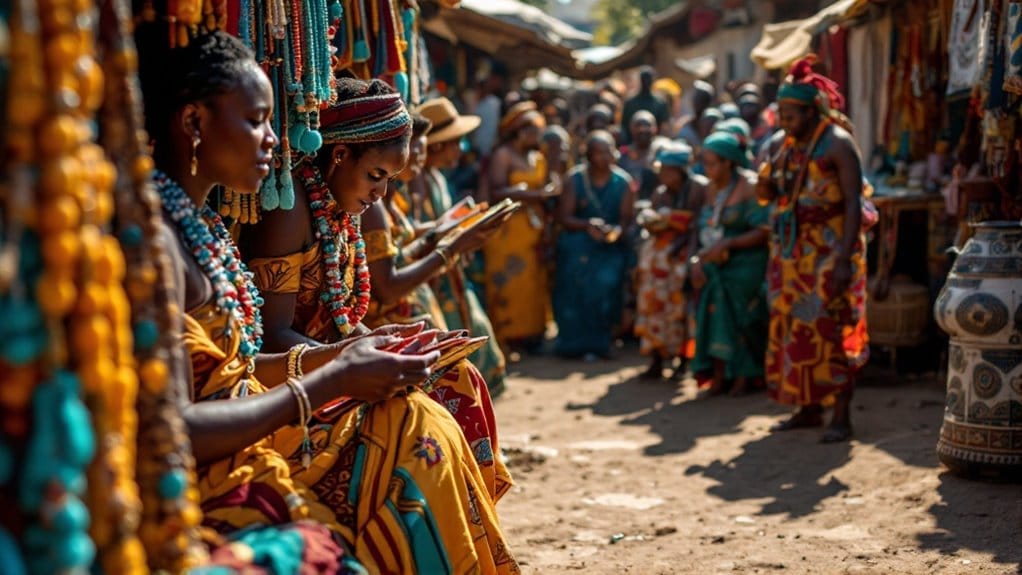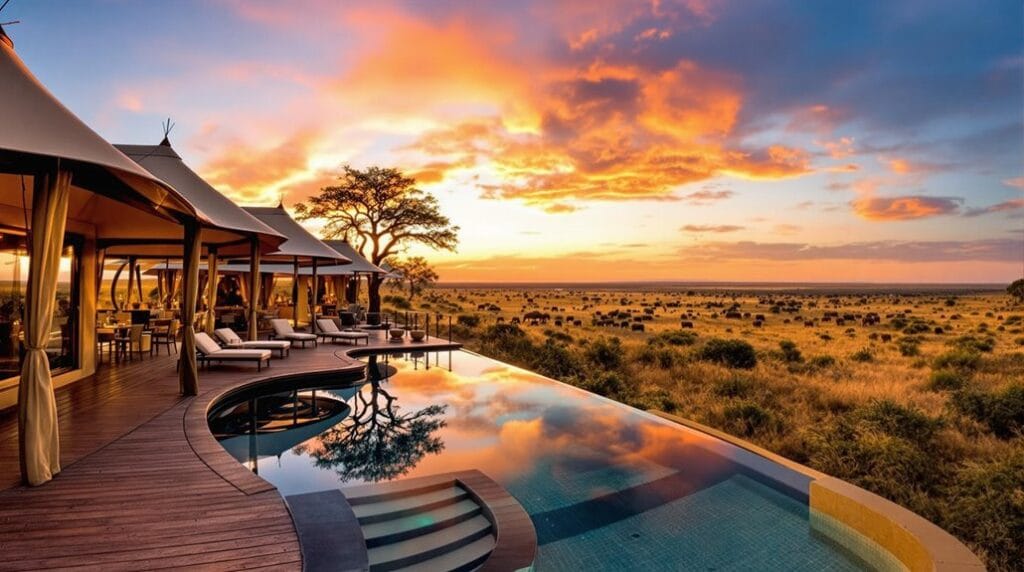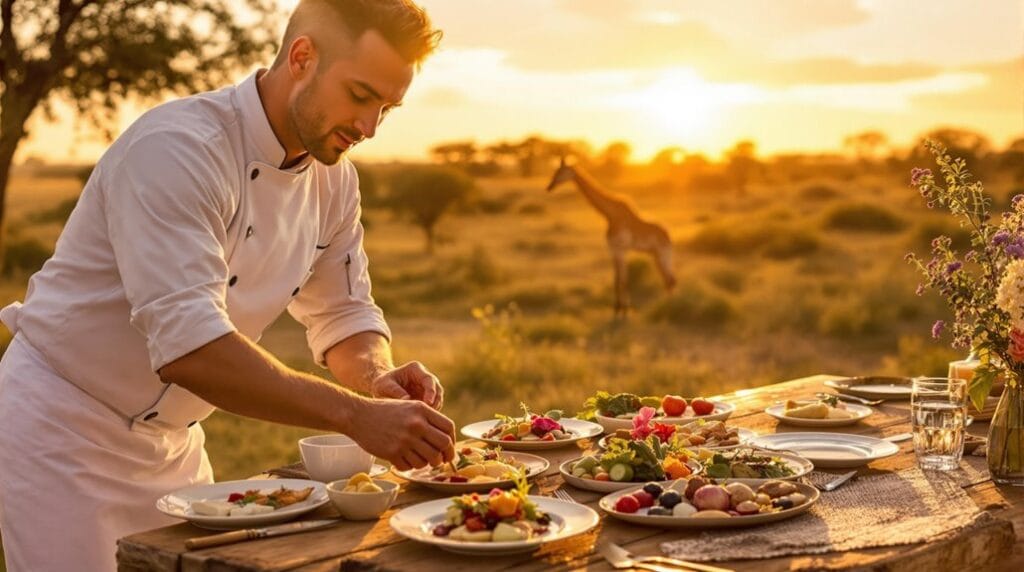To immerse yourself in indigenous art experiences in Africa, start by choosing artisans from recognized communities and purchase directly from them. Engage in local workshops to learn traditional techniques and cultural significance. Attend cultural festivals to connect with artists and their stories. Respect local traditions while documenting your experiences through sketches or photos. Support sustainable tourism that benefits artisans. Participate in community-led initiatives and advocate for indigenous artists' recognition. Sharing your journey helps amplify their voices. By exploring these aspects further, you'll uncover more ways to enrich your experience and foster meaningful connections.
Key Takeaways
- Engage directly with indigenous artisans by attending local markets and cultural festivals to support their communities and learn about their art forms.
- Participate in workshops that focus on traditional crafts such as weaving, pottery, and wood carving to gain hands-on experience with indigenous techniques.
- Explore museums like Musée National du Cameroun and Marrakech Museum to understand the historical context and cultural significance of indigenous artworks.
- Advocate for local artisans by purchasing genuine indigenous art and supporting community-led initiatives that promote sustainable tourism and craftsmanship.
- Document your experiences through journals or photography, while respecting local customs, to capture insights and reflections on indigenous art.
Choose Authentic Artisans
When exploring the vibrant world of indigenous art in Africa, choosing authentic artisans is crucial. You'll want to seek out those who are part of recognized indigenous communities, like the San people in Botswana. This guarantees that the art you encounter reflects genuine cultural practices and traditions, connecting you to the heart of the local communities.
When you purchase directly from artisans at local markets, such as the bustling spots in Marrakech, you're not just buying art; you're supporting the artists and their communities. This connection fosters a sense of belonging, allowing you to appreciate the stories and histories behind each piece.
Take the time to investigate the techniques and history of the artworks showcased in places like the Musée National du Cameroun. This knowledge deepens your understanding of the craftsmanship involved.
Attending cultural festivals, such as those organized by the Marrakech Museum for Photography and Visual Art, offers another layer of connection. Here, you can meet indigenous artists, absorb their insights, and truly engage with the rich tapestry of their art.
Engage in Local Workshops
How can you deepen your appreciation for indigenous art? One of the best ways is to engage in local workshops. These hands-on experiences immerse you in the vibrant culture and traditions of the local community.
When you participate in workshops at places like the Ethnological Museum in Addis Ababa, you'll connect directly with local artisans, learning their crafts and techniques. It's more than just a class; it's a chance to foster relationships and share stories that enrich your understanding.
In Marrakech, the Museum for Photography and Visual Art invites you to collaborate with indigenous artists, allowing you to create unique pieces influenced by their culture.
Similarly, at Musée National du Cameroun, you can explore the traditional crafts of the Bamoun people, like weaving and pottery, preserving their artisanal heritage.
The National Museum of Ghana offers interactive workshops that teach kente weaving and wood carving, promoting cultural understanding.
Meanwhile, community-based workshops at Matemwe Lodge in Zanzibar support sustainable tourism and provide authentic cultural exchanges.
Learn Cultural Significance
To truly appreciate indigenous art in Africa, you need to explore its historical context and the symbolism embedded within each piece.
These artworks aren't just decorations; they tell stories and reflect the values of the communities they originate from.
Historical Context Exploration
Indigenous art in Africa offers a profound glimpse into the historical and cultural narratives of its diverse ethnic groups. By immersing yourself in these artistic expressions, you can learn about the rich cultural heritage that shapes the continent.
Here are some ways to explore the historical context:
- Visit the Musée National du Cameroun to admire traditional craftsmanship, especially from the Bamoun people.
- Explore the National Museum of Burkina Faso, where masks and statues reveal essential representations of various cultural practices and beliefs.
- Attend workshops at the Ethnological Museum in Addis Ababa, which promote understanding of the significance of indigenous art forms in cultural identity.
- Discover contemporary interpretations of traditional themes at the Marrakech Museum for Photography and Visual Art, bridging the gap between past and present.
Engaging with these experiences not only deepens your appreciation for African art but also fosters a sense of belonging to a broader cultural tapestry.
Recognizing the historical context of these art forms enriches your understanding and connection to the diverse communities that have shaped their narratives.
Symbolism in Artwork
Art in Africa is rich with symbolism, reflecting the deep cultural significance embedded within each piece. When you explore African cultural artwork, pay attention to the symbols and colors used.
Take the Adinkra symbols from Ghana, for instance—each one conveys powerful concepts like wisdom, strength, and unity. Understanding these symbols can deepen your appreciation for the art.
Colors also have specific meanings; red may symbolize sacrifice or love, while black often represents the people or the earth. As you admire textiles or carvings, notice the unique motifs and patterns—these aren't just decorative; they tell stories and reveal the history and social status of the community.
Masks, such as those from the Bamoun people in Cameroon, serve important roles beyond mere decoration. They embody ancestral spirits and cultural values, playing essential parts in rituals and ceremonies.
Respect Community Traditions
When you engage with indigenous artists, you're not just appreciating their craft; you're acknowledging the rich traditions that shape their work.
It's essential to learn about their local practices and the stories behind each piece, as this deepens your understanding and respect for their culture.
Acknowledge Local Practices
Visiting museums and cultural venues in Africa offers a unique opportunity to engage with the rich tapestry of local traditions. To truly immerse yourself in the experience, it's essential to acknowledge and respect the practices that shape the indigenous art forms you encounter.
Here are a few tips to enhance your visit:
- Learn the Craft: Participate in workshops like those at the Ethnological Museum in Addis Ababa, where you can learn directly from local artists about their techniques and cultural meanings.
- Embrace Storytelling: Recognize the importance of traditional storytelling in art, as seen in the National Museum of Ghana, to deepen your understanding of the artworks' historical context.
- Support Community Collaboration: Visit venues like the Marrakech Museum for Photography and Visual Art, which highlight community involvement in curating exhibits that reflect local values and stories.
- Engage in Festivals: Attend cultural festivals organized by museums to appreciate indigenous practices and contribute to the sustainability of these art forms.
Engage Indigenous Artists
Engaging with indigenous artists offers a profound way to respect and celebrate community traditions. By collaborating with local talent, like those featured in the Ethnological Museum in Addis Ababa, you guarantee that cultural practices and artistic expressions are authentically represented. This mutual understanding fosters a deeper connection to the art and the people behind it.
Attend workshops and seminars at places such as the Marrakech Museum for Photography and Visual Art, where indigenous artists share their techniques and cultural narratives. These experiences enrich your appreciation and respect for their heritage.
Supporting initiatives at the Musée National du Cameroun allows you to witness traditional craftsmanship being preserved and celebrated, while engaging with community-led projects at the National Museum of Ghana helps artisans showcase their work, instilling pride and ownership.
Participating in cultural exchange programs creates opportunities for direct interaction with indigenous artists. These dialogues not only enhance your understanding of their unique traditions but also build bridges of respect and appreciation.
In embracing their art, you help honor their stories and contribute to the sustainability of their cultural legacy.
Support Sustainable Practices
Supporting sustainable practices in indigenous art not only empowers local communities but also enriches your own experience. By engaging with these practices, you become part of a movement that respects and honors the rich cultural heritage of Africa.
Here are some ways to support sustainable practices while enjoying indigenous art:
- Join Community Workshops: Participate in workshops, like those at the Marrakech Museum for Photography and Visual Art, where you can learn from local artisans and support their economic empowerment.
- Buy Authentic Crafts: Purchase handmade crafts from places like the Musée National du Cameroun. Your contributions directly benefit the local community and help preserve traditional craftsmanship.
- Attend Cultural Festivals: Engage with cultural festivals organized by museums, which foster awareness and appreciation for indigenous art while promoting sustainable tourism practices.
- Collaborate with Organizations: Work with groups like ADORE Africa, which prioritize conservation and community development, enhancing both sustainability and local economies.
Explore Diverse Art Forms
Explore the vibrant tapestry of indigenous art forms in Africa, where each piece tells a story steeped in cultural identity and historical significance.
You'll find that indigenous art encompasses a wide range of forms, including traditional crafts, textiles, sculpture, and painting. Each artwork reflects the unique narratives of various ethnic groups, allowing you to connect deeply with their histories.
Dive into the intricate artisanal crafts of the Bamoun people in Cameroon at the Museum Bamoun, where their rich artistic heritage is preserved.
In Ethiopia, the National Museum showcases both traditional and contemporary art, highlighting the country's diverse ethnic identities and artistic expressions.
Don't miss the Marrakech Museum for Photography and Visual Art, which actively supports indigenous artists through cultural exchange programs, bridging the gap between traditional and modern art forms.
Explore the Musée National du Cameroun, where you'll find sections dedicated to indigenous art that showcase the craftsmanship and rich cultural tapestry of Cameroonian traditions.
Participate in Cultural Events
Participating in cultural events across Africa offers you a unique opportunity to immerse yourself in the rich traditions and artistic expressions of indigenous communities. By engaging with local customs and practices, you'll foster a sense of belonging and connection.
Here are some ways to engage:
- Attend cultural festivals at local museums, like the Marrakech Museum for Photography and Visual Art, where indigenous artists showcase their work and share their stories.
- Join workshops and seminars at the Ethnological Museum in Addis Ababa, focusing on Ethiopian heritage, where you can create traditional crafts and hear enchanting stories.
- Engage with communities through guided village tours offered by places like Matemwe Lodge in Zanzibar, which support community projects and provide genuine cultural insights.
- Experience traditional performances, such as Intore dance shows at the Mountain Gorilla View Lodge, connecting you with the region's vibrant cultural heritage.
These interactive experiences not only enrich your understanding of indigenous art but also create lasting memories and friendships.
Document Your Experiences
As you journey through Africa's vibrant indigenous art scene, documenting your experiences enriches your understanding and connection to the culture. Bringing a journal or sketchbook allows you to capture your thoughts and feelings, fostering a deeper appreciation for the artwork and its cultural significance.
Utilizing photography can also help you document your experiences. Remember to respect local customs and seek permission when photographing individuals or sacred sites. Recording audio or video reflections preserves your immediate reactions and insights, creating a personal narrative of your journey.
Consider compiling your memories into a digital scrapbook or blog to share your immersive experiences with others. This not only promotes awareness of indigenous cultures but also uplifts the voices of local artists.
Here's a quick guide to documenting your experiences:
| Method | Tips for Success |
|---|---|
| Journal/Sketchbook | Capture thoughts and emotions |
| Photography | Respect customs; seek permission |
| Audio/Video Reflections | Record immediate reactions |
| Digital Scrapbook/Blog | Compile images and notes |
| Social Media | Share highlights; tag local artists |
Share With Local Communities
When you participate in collaborative art projects with local communities, you not only learn valuable skills but also contribute to a shared cultural experience.
Engaging in cultural workshops and events allows you to appreciate indigenous traditions firsthand while supporting local artisans. This connection fosters a deeper understanding of the rich artistic heritage that defines these communities.
Collaborative Art Projects
Collaborative art projects breathe life into indigenous cultures by connecting local communities with artists and curators.
When you engage with these projects, you not only interact with vibrant cultures but also help preserve unique indigenous art forms.
Here are four ways you can immerse yourself in these enriching experiences:
- Participate in workshops: Join sessions at places like the National Museum of Ghana, where you can learn traditional crafting techniques directly from local artisans.
- Engage with art residencies: Visit the Marrakech Museum for Photography and Visual Art, where indigenous artists showcase their work while fostering community dialogue.
- Support local narratives: At the National Museum of Burkina Faso, you'll find community-driven projects that celebrate local craftsmanship and storytelling through art.
- Explore contemporary influences: Check out the Zoma Museum in Addis Ababa, where you can witness how local traditions influence modern artistic expressions.
Cultural Workshops and Events
Cultural workshops and events serve as essential bridges between local communities and visitors, fostering a deeper understanding of indigenous art. When you participate in workshops, like those at the Ethnological Museum in Addis Ababa, you engage directly with local artisans, learning traditional techniques that have been passed down through generations. Such experiences not only enrich your appreciation of the art but also connect you to the culture.
Events at places like the Marrakech Museum for Photography and Visual Art often showcase artist residencies, encouraging cultural exchange and collaboration. You'll find that the National Museum of Ghana involves local communities in creating and conserving indigenous art, instilling a sense of ownership and pride.
Similarly, the National Museum of Burkina Faso offers hands-on workshops, such as mask-making, where you can work side-by-side with skilled artisans.
Don't miss cultural festivals at the Zeitz Museum of Contemporary Art Africa, where indigenous artistic expressions come to life through vibrant performances and exhibitions. By sharing these moments with local communities, you not only witness the beauty of indigenous art but also become a part of its living legacy.
Advocate for Indigenous Artists
Supporting indigenous artists is essential not only for preserving their unique craftsmanship but also for celebrating their cultural heritage. When you advocate for these talented individuals, you're helping to weave their stories into the fabric of the wider African and global art scene.
Here are a few impactful ways you can support indigenous artists:
- Visit Museums: Explore institutions like the Musée National du Cameroun or the Marrakech Museum for Photography, which showcase indigenous art and provide platforms for local artists.
- Engage with Digital Archives: Access collections at the Mohamed VI Museum of Modern and Contemporary Art, allowing you to appreciate and share indigenous art with a global audience.
- Participate in Community Initiatives: Support programs at places like the Ethnological Museum in Addis Ababa that involve local communities in curating exhibitions, ensuring authentic representation.
- Promote Art Tourism: Engage with initiatives like Kaya Mawa on Likoma Island, which not only highlights artists but also supports local employment and community projects.
Frequently Asked Questions
How to Create an Immersive Art Experience?
To create an immersive art experience, you can start by designing interactive installations that invite participation.
Incorporate cultural storytelling that resonates with visitors, allowing them to connect deeply with the art.
Use engaging visuals and soundscapes to evoke emotions, making the experience memorable.
Encourage collaboration by hosting workshops where attendees can express themselves creatively.
What Techniques Are Used in African Art?
When you explore African art, you're diving into a world where traditional materials like wood and clay come alive with cultural symbolism.
Imagine visiting a village where artisans handcraft intricate masks from local wood, each design telling stories of ancestors and traditions.
You'll discover that techniques like weaving and dyeing also convey deep meanings; for instance, Ghanaian textiles use Adinkra symbols to express thoughts and values, making every piece a connection to heritage and identity.
What Is the Concept of Art in Indigenous African Society?
In indigenous African society, art holds immense cultural significance and reflects deep spiritual symbolism.
You'll find that art isn't just for beauty; it's an essential part of community life, showcasing shared traditions and values.
When you engage with these artworks, you're connecting to a collective heritage that fosters a sense of belonging.
Each piece tells a story, bridging the material and spiritual worlds, and inviting you to participate in a living cultural narrative.
What Do You Think Makes African Art Different From Other Art Forms in Different Parts of the World?
African art stands out because it's deeply rooted in cultural significance and spiritual symbolism.
When you explore this art, you'll notice how it reflects community narratives and traditions, unlike many Western forms that focus on individual expression.
The vibrant colors and intricate patterns tell stories that connect you to the environment and collective identity.
Engaging with African art helps you feel a sense of belonging, enriching your understanding of spirituality and community.
Conclusion
In your journey to experience Africa's vibrant indigenous art, remember that "a picture is worth a thousand words." By choosing authentic artisans and engaging with local communities, you not only enrich your understanding but also help preserve these beautiful traditions. Embrace the cultural significance, participate in workshops, and advocate for artists. Your efforts can create a ripple effect, fostering respect and sustainability while celebrating the incredible artistry that defines Africa's rich heritage.








